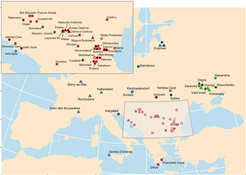Ancient DNA Study Reveals the Prehistory of Southeastern Europe
Second largest ancient DNA study provides insight into the arrival of the first farmers to Europe and their interactions with hunter-gatherers.

Starting around 8,500 years ago, agriculture spread into Europe from the southeast, accompanied by a movement of people from Anatolia. This study reports data from the genomes of 225 ancient people who lived both before and after this transition, and documents the interaction and mixing of these two genetically different groups of people. “Southeastern Europe was the beachhead in the spread of farming from Anatolia into Europe. This study is the first to provide a rich genetic characterization of this process by showing how the indigenous population interacted with incoming Asian immigrants at this extraordinary moment in the past,” says Songül Alpaslan-Roodenberg, a consulting anthropologist at Harvard Medical School, who identified and sampled many of the skeletons.
“In some places, hunter-gatherers and incoming farmers seem to have mixed very quickly,” says first author Iain Mathieson, a geneticist at the University of Pennsylvania, “but mostly the two groups remained isolated, at least for the first few hundred years. These hunter-gatherers had been living there for thousands of years, and it must have been quite a shock to have these new people show up—with a completely different lifestyle and appearance.”
“Three thousand years later, they were thoroughly mixed,” continues David Reich of Harvard Medical School, the Broad Institute of MIT and Harvard and the Howard Hughes Medical Institute, who co-directed the study. “Some populations derived up to a quarter of their ancestry from hunter-gatherers.” In other parts of Europe, this mixing was marked by a so-called sex bias, with most of the hunter-gatherer ancestry contributed by men. In the southeast, however, the pattern was different. “This shows that the mode of interaction between the two groups was different in different places, something we need to try to understand in the context of the archaeological evidence,” added Mathieson.
The new paper also dramatically increases the number of samples from the population of hunter-gatherers that inhabited Europe before the farmers. The study reports a particularly rich sampling of forty hunter-gatherers and early farmers from six archaeological sites from the Iron Gates region, which straddles the border of present-day Romania and Serbia. The genetic results show that the region witnessed intensive interaction between hunter-gatherers and farmers. Out of four individuals from the site of Lepenski Vir, for example, two had entirely Anatolian farmer-related ancestry, fitting with isotope evidence that they were migrants from outside the Iron Gates region, while a third individual had a mixture of ancestries and consumed aquatic resources, as expected if farmers were being integrated into hunter-gatherer groups or were adopting a hunter-gatherer lifestyle.
“These results reveal the relationship between migrations, admixture and subsistence in the this key region and show that even within early European farmers, individuals differed in their ancestry, reflecting a dynamic mosaic of hunter-farmer interbreeding,” adds Ron Pinhasi, an anthropologist at the University for Vienna, who co-directed the study.
The new paper also reports ancient DNA from the people who lived at iconic archaeological sites such as Varna, one of the first places in the world where there is evidence of extreme wealth inequality, with one individual from whom the study obtained data buried with more gold than all other known burials of the period. “The DNA from the famous Varna burial is genetically similar to that of other early European farmers. However, we also find one individual from Varna and several individuals at neighboring sites in Bulgaria who had ancestry from the eastern European steppe. This is the earliest evidence of steppe ancestry this far west—two thousand years before the mass migration from the steppe that replaced more than half of the population of northern Europe,” says Johannes Krause, Director of the Department of Archaeogenetics at the Max Planck Institute for the Science of Human History, who led the work on Varna.
Adds Reich, “These very large ancient DNA studies, involving intense collaboration between geneticists and archaeologists, make it possible to build up a rich picture of key periods of the past that could only be weakly glimpsed before. Studies on this scale represent a coming of age for the field of ancient DNA—I look forward to what we will learn when similar approaches are applied elsewhere in the world.”
This study was conducted by an international team of 117 archaeologists, anthropologists, and geneticists from 82 institutions across Europe and the United States.
